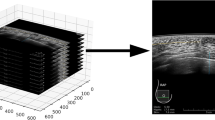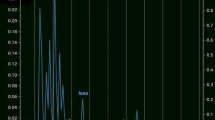Abstract
Objectives
To evaluate a deep convolutional neural network (dCNN) for detection, highlighting, and classification of ultrasound (US) breast lesions mimicking human decision-making according to the Breast Imaging Reporting and Data System (BI-RADS).
Methods and materials
One thousand nineteen breast ultrasound images from 582 patients (age 56.3 ± 11.5 years) were linked to the corresponding radiological report. Lesions were categorized into the following classes: no tissue, normal breast tissue, BI-RADS 2 (cysts, lymph nodes), BI-RADS 3 (non-cystic mass), and BI-RADS 4–5 (suspicious). To test the accuracy of the dCNN, one internal dataset (101 images) and one external test dataset (43 images) were evaluated by the dCNN and two independent readers. Radiological reports, histopathological results, and follow-up examinations served as reference. The performances of the dCNN and the humans were quantified in terms of classification accuracies and receiver operating characteristic (ROC) curves.
Results
In the internal test dataset, the classification accuracy of the dCNN differentiating BI-RADS 2 from BI-RADS 3–5 lesions was 87.1% (external 93.0%) compared with that of human readers with 79.2 ± 1.9% (external 95.3 ± 2.3%). For the classification of BI-RADS 2–3 versus BI-RADS 4–5, the dCNN reached a classification accuracy of 93.1% (external 95.3%), whereas the classification accuracy of humans yielded 91.6 ± 5.4% (external 94.1 ± 1.2%). The AUC on the internal dataset was 83.8 (external 96.7) for the dCNN and 84.6 ± 2.3 (external 90.9 ± 2.9) for the humans.
Conclusion
dCNNs may be used to mimic human decision-making in the evaluation of single US images of breast lesion according to the BI-RADS catalog. The technique reaches high accuracies and may serve for standardization of highly observer-dependent US assessment.
Key Points
• Deep convolutional neural networks could be used to classify US breast lesions.
• The implemented dCNN with its sliding window approach reaches high accuracies in the classification of US breast lesions.
• Deep convolutional neural networks may serve for standardization in US BI-RADS classification.






Similar content being viewed by others
Abbreviations
- ABUS:
-
Automatic breast ultrasound
- ACR BI-RADS:
-
American College of Radiology Breast Imaging Reporting and Data System
- AUC:
-
Area under the curve
- dCNN:
-
Deep convolutional neural network
- DM:
-
Digital mammography
- MD:
-
Metadata
- NT:
-
Normal tissue
- RIS:
-
Radiological information system
- ROC curves:
-
Receiver operating characteristic curves
- US:
-
Ultrasound
References
Independent UK Panel on Breast Cancer Screening (2012) The benefits and harms of breast cancer screening: an independent review. Lancet 380:1778–1786
Akin O, Brennan SB, Dershaw DD et al (2012) Advances in oncologic imaging: update on 5 common cancers. CA Cancer J Clin 62:364–393
Lång K, Andersson I, Zackrisson S (2014) Breast cancer detection in digital breast tomosynthesis and digital mammography-a side-by-side review of discrepant cases. Br J Radiol 87:20140080
Boyd NF, Martin LJ, Yaffe MJ, Minkin S (2011) Mammographic density and breast cancer risk: current understanding and future prospects. Breast Cancer Res 13:223
Brisson J (1991) Family history of breast cancer, mammographic features of breast tissue, and breast cancer risk. Epidemiology 2:440–444
Vourtsis A, Berg WA (2018) Breast density implications and supplemental screening. Eur Radiol. https://doi.org/10.1007/s00330-018-5668-8
Njor SH, Schwartz W, Blichert-Toft M, Lynge E (2015) Decline in breast cancer mortality: how much is attributable to screening? J Med Screen 22:20–27
Berg WA, Blume JD, Cormack JB et al (2008) Combined screening with ultrasound and mammography vs mammography alone in women at elevated risk of breast cancer. JAMA 299:2151–2163
Stavros AT, Thickman D, Rapp CL, Dennis MA, Parker SH, Sisney GA (1995) Solid breast nodules: use of sonography to distinguish between benign and malignant lesions. Radiology 196:123–134
Kelly KM, Dean J, Comulada WS, Lee SJ (2010) Breast cancer detection using automated whole breast ultrasound and mammography in radiographically dense breasts. Eur Radiol 20:734–742
Yap MH, Pons G, Marti J et al (2017) Automated breast ultrasound lesions detection using convolutional neural networks. IEEE J Biomed Health Inform. https://doi.org/10.1109/JBHI.2017.2731873
Kuhl CK (2017) Abbreviated breast MRI for screening women with dense breast: the EA1141 Trial. Br J Radiol. https://doi.org/10.1259/bjr.20170441:20170441
Lee HJ, Kim EK, Kim MJ et al (2008) Observer variability of Breast Imaging Reporting and Data System (BI-RADS) for breast ultrasound. Eur J Radiol 65:293–298
Park CS, Lee JH, Yim HW et al (2007) Observer agreement using the ACR Breast Imaging Reporting and Data System (BI-RADS)-ultrasound, first edition (2003). Korean J Radiol 8:397–402
Tosteson AN, Fryback DG, Hammond CS et al (2014) Consequences of false-positive screening mammograms. JAMA Intern Med 174:954–961
Stavros AT, Freitas AG, deMello GGN et al (2017) Ultrasound positive predictive values by BI-RADS categories 3-5 for solid masses: an independent reader study. Eur Radiol. https://doi.org/10.1007/s00330-017-4835-7
Zagouri F, Sergentanis TN, Gounaris A et al (2008) Pain in different methods of breast biopsy: emphasis on vacuum-assisted breast biopsy. Breast 17:71–75
Yazici B, Sever AR, Mills P, Fish D, Jones SE, Jones PA (2006) Scar formation after stereotactic vacuum-assisted core biopsy of benign breast lesions. Clin Radiol 61:619–624
Berg WA, Zhang Z, Lehrer D et al (2012) Detection of breast cancer with addition of annual screening ultrasound or a single screening MRI to mammography in women with elevated breast cancer risk. JAMA 307:1394–1404
Tice JA, Lee JM, Pearson SD (2014) The comparative clinical effectiveness and value of supplemental screening tests following negative mammography in women with dense breast tissue. Institute for Clinical & Economic Review
Ardakani AA, Gharbali A, Mohammadi A (2015) Classification of breast tumors using sonographic texture analysis. J Ultrasound Med 34:225–231
Yap MH, Yap CH (2016) Breast ultrasound lesions classification: a performance evaluation between manual delineation and computer segmentation. In: Abbey CK, Kupinski MA (eds) Medical Imaging 2016: Image Perception, Observer Performance, and Technology Assessment 9787
Min-Chun Yang, Woo Kyung Moon, Wang YC et al (2013) Robust texture analysis using multi-resolution gray-scale invariant features for breast sonographic tumor diagnosis. IEEE Trans Med Imaging 32:2262–2273
Newell D, Nie K, Chen JH et al (2010) Selection of diagnostic features on breast MRI to differentiate between malignant and benign lesions using computer-aided diagnosis: differences in lesions presenting as mass and non-mass-like enhancement. Eur Radiol 20:771–781
Han S, Kang HK, Jeong JY et al (2017) A deep learning framework for supporting the classification of breast lesions in ultrasound images. Phys Med Biol 62:7714–7728
Becker AS, Mueller M, Stoffel E, Marcon M, Ghafoor S, Boss A (2017) Classification of breast cancer from ultrasound imaging using a generic deep learning analysis software: a pilot study. Br J Radiol. https://doi.org/10.1259/bjr.20170576:20170576
Cheng JZ, Ni D, Chou YH et al (2016) Computer-aided diagnosis with deep learning architecture: applications to breast lesions in US images and pulmonary nodules in CT scans. Sci Rep 6:24454
Bradski G (2000) The OpenCV library. Dr. Dobb’s Journal of Software Tools. UBM Technology Group, San Francisco
Rodtook A, Makhanov SS (2013) Multi-feature gradient vector flow snakes for adaptive segmentation of the ultrasound images of breast cancer. J Vis Commun Image Represent 24:1414–1430
Joo S, Yang YS, Moon WK, Kim HC (2004) Computer-aided diagnosis of solid breast nodules: use of an artificial neural network based on multiple sonographic features. IEEE Trans Med Imaging 23:1292–1300
Mogatadakala KV, Donohue KD, Piccoli CW, Forsberg F (2006) Detection of breast lesion regions in ultrasound images using wavelets and order statistics. Med Phys 33:840–849
Moon WK, Lo CM, Chang JM, Huang CS, Chen JH, Chang RF (2013) Quantitative ultrasound analysis for classification of BI-RADS category 3 breast masses. J Digit Imaging 26:1091–1098
Acknowledgements
The work was supported by the Clinical Research Priority Program of the Faculty of Medicine of the University of Zurich “Artificial Intelligence in oncological Imaging Network”.
Funding
The authors state that this work has not received any funding.
Author information
Authors and Affiliations
Corresponding author
Ethics declarations
Guarantor
The scientific guarantor of this publication is Prof. Dr. med Andreas Boss.
Conflict of interest
The authors of this manuscript declare no relationships with any companies, whose products or services may be related to the subject matter of the article.
Statistics and biometry
No complex statistical methods were necessary for this paper.
Informed consent
Written informed consent was waived by the Institutional Review Board.
Ethical approval
Institutional Review Board approval was obtained.
Methodology
• retrospective
• experimental
• performed at one institution
Additional information
Publisher’s note
Springer Nature remains neutral with regard to jurisdictional claims in published maps and institutional affiliations.
Electronic supplementary material
ESM 1
(DOCX 21 kb)
Rights and permissions
About this article
Cite this article
Ciritsis, A., Rossi, C., Eberhard, M. et al. Automatic classification of ultrasound breast lesions using a deep convolutional neural network mimicking human decision-making. Eur Radiol 29, 5458–5468 (2019). https://doi.org/10.1007/s00330-019-06118-7
Received:
Revised:
Accepted:
Published:
Issue Date:
DOI: https://doi.org/10.1007/s00330-019-06118-7




